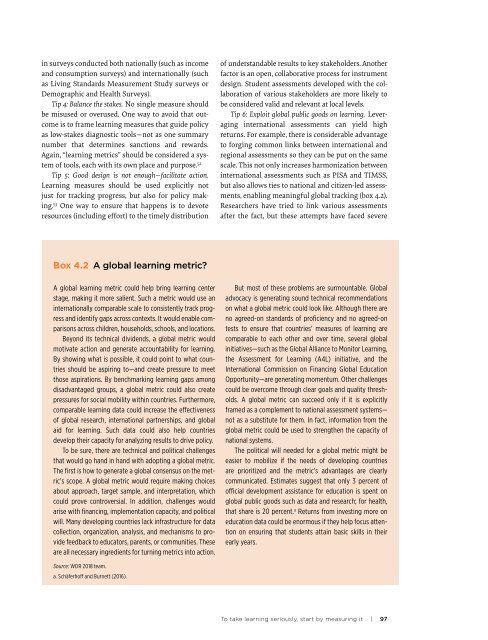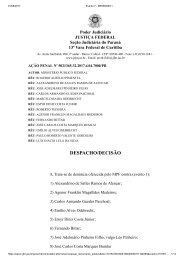Brasil só deve dominar Leitura em 260 anos, aponta estudo do Banco Mundial Relatorio Banco Mundial _Learning
You also want an ePaper? Increase the reach of your titles
YUMPU automatically turns print PDFs into web optimized ePapers that Google loves.
in surveys conducted both nationally (such as income<br />
and consumption surveys) and internationally (such<br />
as Living Standards Measur<strong>em</strong>ent Study surveys or<br />
D<strong>em</strong>ographic and Health Surveys).<br />
Tip 4: Balance the stakes. No single measure should<br />
be misused or overused. One way to avoid that outcome<br />
is to frame learning measures that guide policy<br />
as low-stakes diagnostic tools—not as one summary<br />
number that determines sanctions and rewards.<br />
Again, “learning metrics” should be considered a syst<strong>em</strong><br />
of tools, each with its own place and purpose. 52<br />
Tip 5: Good design is not enough—facilitate action.<br />
<strong>Learning</strong> measures should be used explicitly not<br />
just for tracking progress, but also for policy making.<br />
53 One way to ensure that happens is to devote<br />
resources (including effort) to the timely distribution<br />
of understandable results to key stakeholders. Another<br />
factor is an open, collaborative process for instrument<br />
design. Student assessments <strong>deve</strong>loped with the collaboration<br />
of various stakeholders are more likely to<br />
be considered valid and relevant at local levels.<br />
Tip 6: Exploit global public goods on learning. Leveraging<br />
international assessments can yield high<br />
returns. For example, there is considerable advantage<br />
to forging common links between international and<br />
regional assessments so they can be put on the same<br />
scale. This not only increases harmonization between<br />
international assessments such as PISA and TIMSS,<br />
but also allows ties to national and citizen-led assessments,<br />
enabling meaningful global tracking (box 4.2).<br />
Researchers have tried to link various assessments<br />
after the fact, but these att<strong>em</strong>pts have faced severe<br />
Box 4.2 Agloballearningmetric?<br />
A global learning metric could help bring learning center<br />
stage, making it more salient. Such a metric would use an<br />
internationally comparable scale to consistently track progress<br />
and identify gaps across contexts. It would enable comparisons<br />
across children, households, schools, and locations.<br />
Beyond its technical dividends, a global metric would<br />
motivate action and generate accountability for learning.<br />
By showing what is possible, it could point to what countries<br />
should be aspiring to—and create pressure to meet<br />
those aspirations. By benchmarking learning gaps among<br />
disadvantaged groups, a global metric could also create<br />
pressures for social mobility within countries. Furthermore,<br />
comparable learning data could increase the effectiveness<br />
of global research, international partnerships, and global<br />
aid for learning. Such data could also help countries<br />
<strong>deve</strong>lop their capacity for analyzing results to drive policy.<br />
To be sure, there are technical and political challenges<br />
that would go hand in hand with a<strong>do</strong>pting a global metric.<br />
The first is how to generate a global consensus on the metric’s<br />
scope. A global metric would require making choices<br />
about approach, target sample, and interpretation, which<br />
could prove controversial. In addition, challenges would<br />
arise with financing, impl<strong>em</strong>entation capacity, and political<br />
will. Many <strong>deve</strong>loping countries lack infrastructure for data<br />
collection, organization, analysis, and mechanisms to provide<br />
feedback to educators, parents, or communities. These<br />
are all necessary ingredients for turning metrics into action.<br />
But most of these probl<strong>em</strong>s are surmountable. Global<br />
advocacy is generating sound technical recommendations<br />
on what a global metric could look like. Although there are<br />
no agreed-on standards of proficiency and no agreed-on<br />
tests to ensure that countries’ measures of learning are<br />
comparable to each other and over time, several global<br />
initiatives—such as the Global Alliance to Monitor <strong>Learning</strong>,<br />
the Assessment for <strong>Learning</strong> (A4L) initiative, and the<br />
International Commission on Financing Global Education<br />
Opportunity—are generating momentum. Other challenges<br />
could be overcome through clear goals and quality thresholds.<br />
A global metric can succeed only if it is explicitly<br />
framed as a compl<strong>em</strong>ent to national assessment syst<strong>em</strong>s—<br />
not as a substitute for th<strong>em</strong>. In fact, information from the<br />
global metric could be used to strengthen the capacity of<br />
national syst<strong>em</strong>s.<br />
The political will needed for a global metric might be<br />
easier to mobilize if the needs of <strong>deve</strong>loping countries<br />
are prioritized and the metric’s advantages are clearly<br />
communicated. Estimates suggest that only 3 percent of<br />
official <strong>deve</strong>lopment assistance for education is spent on<br />
global public goods such as data and research; for health,<br />
that share is 20 percent. a Returns from investing more on<br />
education data could be enormous if they help focus attention<br />
on ensuring that students attain basic skills in their<br />
early years.<br />
Source: WDR 2018 team.<br />
a. Schäferhoff and Burnett (2016).<br />
To take learning seriously, start by measuring it | 97








